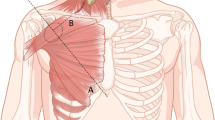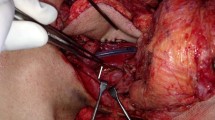Abstract
Background
Total laryngeal and hypopharyngeal resection remained to be the mainly treatment option for advanced hypopharyngeal cancer, which resulted in complicated reconstructive challenge for circumferential hypopharyngeal defect. The pedicled thoracoacromial artery compound flaps included Thoracoacromial artery perforator (TAAP) flap and pectoralis major myocutaneous (PMMC) flap. This study is to evaluate the clinical application of the pedicled thoracoacromial artery compound flaps for circumferential hypopharyngeal reconstruction.
Methods
From May 2021 to April 2022, four hypopharyngeal cancer patients with circumferential hypopharyngeal defects were reconstructed by the pedicled thoracoacromial artery compound flaps. All patients were males. Patient age ranged from 35 to 62 years (average, 50 years). The Shoulder function were evaluated by SPADI. The average follow-up was 10.25 months (range from 4 to 18 months).
Results
All of the pedicled thoracoacromial artery compound flaps in our study survived. The defect length between tongue base and cervical esophagus ranged from 8 to 10 cm after total laryngeal and hypopharyngeal resection. The TAAP flap size ranged from 6 × 7 cm to 7 × 10 cm, and the PMMC flap size ranged from 6 × 7 cm to 9 × 12 cm. The pedicle length of TAAP and PMMC flaps varied, respectively, from 5 to 8 cm (mean 6.5 cm) and 7 cm to 11 cm (mean 8.75 cm). The mean time of TAAP and PMMC flaps harvest was, respectively, 82 min and 39 min. All patients were able to resume soft diet in the fourth week of postoperation, but one patient was operated by gastrostomy in the second month of postoperation because of pharyngeal cavity stenosis, and the patient successfully resumed oral soft diet by endoscopic balloon dilation after postoperation radiotherapy. All patients have resumed oral feeding at last. There were mild dysfunction for our patients according to SPADI during the mid–long follow-up.
Conclusions
The pedicled thoracoacromial artery compound flaps have stable blood supply and provide adequate muscle coverage for greater protection during radiotherapy, and the microsurgical skills have no requirement. Therefore, the compound flaps provide a good choice for the reconstruction of circumferential hypopharyngeal defect, especially in the aged or patients with comorbidities who are not able to tolerate prolonged surgery.


Similar content being viewed by others

Data availability
The data sets presented in this article are not freely available because of patient confidentiality and participant privacy terms.
References
Kwon DI, Miles BA (2019) Hypopharyngeal carcinoma: do you know your guidelines? Head Neck 41(3):569–576
Wei WI, Chan JYW (2019) Surgical treatment of advanced staged hypopharyngeal cancer. Adv Otorhinolaryngol 83:66–75
Marzouki H, Addas MA, Nujoom M, Zawawi F, Almarzouki HZ (2022) Hypopharyngeal reconstruction: possibilities, outcomes, and updates for improving the human health for quality of life. Comput Intell Neurosci 2022:6132481
Patel RS, Goldstein DP, Brown D, Irish J, Gullane PJ, Gilbert RW (2010) Circumferential pharyngeal reconstruction: history, critical analysis of techniques, and current therapeutic recommendations. Head Neck 32(1):109–120
Gooi Z, Gourin CG, Boahene KD, Byrne PJ, Richmon JD (2015) Temporal trends in head and neck cancer surgery reconstruction. Head Neck 37(10):1509–1517
Geddes CR, Tang M, Yang D, Morris SF (2003) An assessment of the anatomical basis of the thoracoacromial artery perforator flap. Can J Plastic Surg = Journal canadien de chirurgie plastique 11(1):23–27
Anehosur V, Dikhit PS, Nagraj N, Jayade B, Kumar N (2020) PMMC flap revisited and its clinical outcome in 150 patients. J Maxillofac Oral Surg 19(1):26–31
Tripathi M, Parshad S, Karwasra RK, Singh V (2015) Pectoralis major myocutaneous flap in head and neck reconstruction: an experience in 100 consecutive cases. Natl J Maxillofac Surg 6(1):37–41
Patel K, Lyu DJ, Kademani D (2014) Pectoralis major myocutaneous flap. Oral Maxillofac Surg Clin North Am 26(3):421–426
Song D, Pafitanis G, Pont LEP, Yang P, Koshima I, Zhang Y, Iida T, Zhou X, Li Z (2018) Chimeric thoracoacromial artery perforator flap for one-staged reconstruction of complex pharyngoesophageal defects: a single unit experience. Head Neck 40(2):302–311
Li Z, Cui J, Zhang YX, Levin LS, Zhou X, Spinelli G, Lazzeri D, Persichetti P (2014) Versatility of the thoracoacromial artery perforator flap in head and neck reconstruction. J Reconstructive Microsurg 30(7):497–503
Breckenridge JD, McAuley JH (2011) Shoulder pain and disability index (SPADI). J Physiother 57(3):197
Kc S, Sharma S (2021) Measurement properties of translated versions of the shoulder pain and disability index: a systematic review. Clin Rehabil 35(3):410–422
Scaglioni MF, Lin TS, Chen YC, Tsai YT, Yang CH, Wu CC, Kuo PJ, Hsieh CH, Yang JC (2018) The free inverted omega-shaped flap for circumferential hypopharyngeal reconstruction with simultaneous neck skin defect. Microsurgery 38(1):51–59
Yu P, Hanasono MM, Skoracki RJ, Baumann DP, Lewin JS, Weber RS, Robb GL (2010) Pharyngoesophageal reconstruction with the anterolateral thigh flap after total laryngopharyngectomy. Cancer 116(7):1718–1724
Aksoyler D, Losco L, Sert G, Chen SH, Chen HC (2021) Risks of laparoscopic harvest of free intestinal flaps for esophageal reconstruction. Surg Laparosc Endosc Percutaneous Techniques 31(6):742–749
Chen HC, Rampazzo A, Gharb BB, Wong MTC, Mardini S, Chen HY, Salgado CJ (2008) Motility differences in free colon and free jejunum flaps for reconstruction of the cervical esophagus. Plast Reconstr Surg 122(5):1410–1416
Lin YS, Mousavi SA, Chen HC (2022) Free colon tissue transfer for the management of xerostomia in head and neck cancer patients: a bacteriological study and clinical case series. J Plastic Reconstructive Aesthetic Surg 75(8):2676–2683
Hayden RE, Nagel TH (2013) The evolving role of free flaps and pedicled flaps in head and neck reconstruction. Curr Opin Otolaryngol Head Neck Surg 21(4):305–310
Wei FC, Jain V, Celik N, Chen HC, Chuang DC, Lin CH (2002) Have we found an ideal soft-tissue flap? An experience with 672 anterolateral thigh flaps. Plastic Reconstructive Surg 109(7):2219–2226 (discussion 2227-2230)
Yu P (2004) Characteristics of the anterolateral thigh flap in a Western population and its application in head and neck reconstruction. Head Neck 26(9):759–769
Spyropoulou GA, Kuo YR, Chien CY, Yang JC, Jeng SF (2009) Buried anterolateral thigh flap for pharyngoesophageal reconstruction: our method for monitoring. Head Neck 31(7):882–887
Yang JC, Kuo YR, Hsieh CH, Jeng SF (2007) The use of radial vessel stump in free radial forearm flap as flap monitor in head and neck reconstruction. Ann Plast Surg 59(4):378–381
Tan NC, Yeh MC, Shih HS, Nebres RP, Yang JC, Kuo YR (2011) Single free anterolateral thigh flap for simultaneous reconstruction of composite hypopharyngeal and external neck skin defect after head and neck cancer ablation. Microsurgery 31(7):524–528
Sagar B, Marres HA, Hartman EH (2010) Hypopharyngeal reconstruction with an anterolateral thigh flap after laryngopharyngeal resection: results of a retrospective study on 20 patients. J Plastic Reconstructive Aesthetic Surg 63(6):970–975
Saint-Cyr M, Schaverien M, Rohrich RJ (2009) Preexpanded second intercostal space internal mammary artery pedicle perforator flap: case report and anatomical study. Plast Reconstr Surg 123(6):1659–1664
Hofer SO, Mureau MA (2010) Pedicled perforator flaps in the head and neck. Clin Plastic Surg 37(4):627–640
Rajan R, Reddy S, Rajan R (1997) The pectoralis major myocutaneous flap in head and neck reconstruction. Indian J Otolaryngol Head Neck Surg 49(4):368–373
Girhe V, Auti AA, Girhe P, Wagre R (2021) Nuts and bolts of PMMC flap in oral cancer and its clinical outcome in 168 Indian patients: a retrospective analysis. J Oral Biol Craniofac Res 11(2):361–364
Mahieu R, Colletti G, Bonomo P, Parrinello G, Iavarone A, Dolivet G, Livi L, Deganello A (2016) Head and neck reconstruction with pedicled flaps in the free flap era. Acta Otorhinolaryngol Ital 36(6):459–468
Deng D, Xu F, Liu J, Li B, Li L, Liu J, Chen F (2020) Clinical application of pedicled thoracoacromial artery perforator flaps for tracheal reconstruction. BMC Surg 20(1):299
Morshed K, Szymański M, Gołabek W (2005) Reconstruction of the hypopharynx with U-shaped pectoralis major myocutaneous flap after total pharyngo-laryngectomy. Eur Arch Otorhinolaryngol 262(4):259–262
Funding
The work was supported by the National Natural Science Foundation of Chongqing (cstc2020jcyj-msxmX1098) and the Joint Science and Health Project of Chongqing (2020FYYX221).
Author information
Authors and Affiliations
Contributions
Conceptualization: ZW, GH. Methodology: ZW, QZ, GH. Data curation: WM, XW. Writing—original draft preparation: ZW, WM. Writing—review and editing, all authors. Visualization: ZW, GH. Supervision: GH. All authors contributed to the article and approved the submitted version.
Corresponding author
Ethics declarations
Conflict of interest
The authors declare that the research was conducted in the absence of any commercial or financial relationships that could be construed as a potential conflict of interest.
Ethics approval and consent to participate
This retrospective review of medical records was approved by the Institutional Review Board of the First Affiliated Hospital of Chongqing Medical University.
Additional information
Publisher's Note
Springer Nature remains neutral with regard to jurisdictional claims in published maps and institutional affiliations.
Rights and permissions
Springer Nature or its licensor (e.g. a society or other partner) holds exclusive rights to this article under a publishing agreement with the author(s) or other rightsholder(s); author self-archiving of the accepted manuscript version of this article is solely governed by the terms of such publishing agreement and applicable law.
About this article
Cite this article
Wang, Z., Ma, W., Wang, X. et al. Pedicled thoracoacromial artery compound flaps for circumferential hypopharyngeal reconstruction. Eur Arch Otorhinolaryngol 280, 4641–4647 (2023). https://doi.org/10.1007/s00405-023-08069-8
Received:
Accepted:
Published:
Issue Date:
DOI: https://doi.org/10.1007/s00405-023-08069-8



